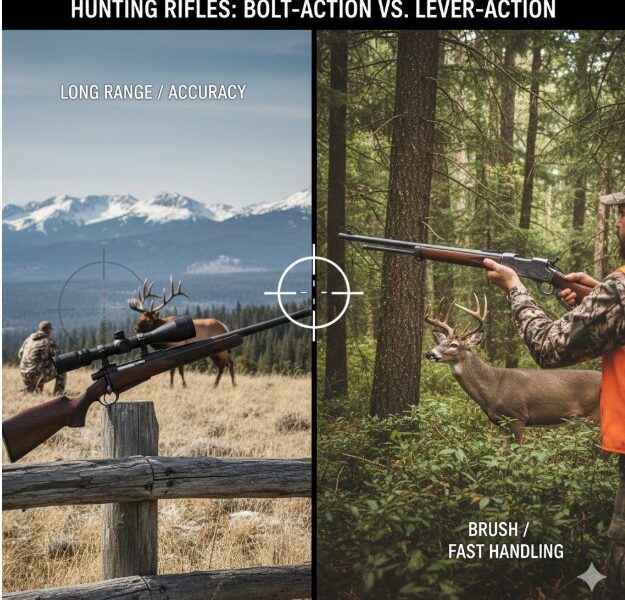Is Bolt-Action Better Than Lever-Action for Hunting

When choosing between bolt-action and lever-action rifles for hunting, the decision ultimately depends on your hunting style, terrain, and target game. Both rifle types have proven themselves over decades of field use, but they excel in different scenarios. This guide breaks down the key differences to help you make an informed decision.
How Do Bolt-Action Rifles Work?
Bolt-action rifles operate using a manually operated bolt mechanism that locks into the chamber. After each shot, the shooter lifts the bolt handle, pulls it back to eject the spent casing, pushes it forward to chamber a new round, and locks it down.
What Are the Advantages of Bolt-Action Rifles for Hunting?
Superior Accuracy: Bolt-action rifles are renowned for their exceptional accuracy. The rigid lockup between the bolt and barrel, combined with minimal moving parts, creates a stable platform that consistently delivers tight groupings at long range.
Long-Range Capability: For hunters pursuing game in open terrain, bolt-action rifles reign supreme. These rifles can reliably reach out to 400-600 yards or more, making them ideal for western hunting scenarios involving pronghorn, mule deer, or elk in mountainous terrain.
Chambering Options: Bolt-action rifles offer the widest selection of calibers, from small varmint rounds like .223 Remington to powerful magnum cartridges like .300 Win Mag and .338 Lapua. This versatility allows hunters to match their rifle perfectly to their quarry.
Scope Compatibility: The straight-line design of bolt-action rifles provides excellent scope mounting options with optimal eye relief, making them the preferred choice for precision shooting. If you’re in the market for quality Langwaffen (long guns) https://dekohülsen.de/c/waffen/langwaffen, bolt-action rifles offer the best platform for mounting high-quality optics essential for long-range hunting.
Reliability in Harsh Conditions: With fewer moving parts exposed to the elements, bolt-action rifles perform consistently in rain, snow, and muddy conditions.
What Are the Disadvantages of Bolt-Action Rifles?
The primary drawback is the slower follow-up shot speed. Operating the bolt requires breaking your shooting position and taking your eye off the target, which can be crucial when hunting dangerous game or in situations requiring rapid shot placement.
How Do Lever-Action Rifles Work?
Lever-action rifles use a lever located around the trigger guard to cycle the action. Pulling the lever down and forward ejects the spent case and chambers a new round in one smooth motion.
Why Do Hunters Choose Lever-Action Rifles?
Faster Follow-Up Shots: The lever-action’s cycling mechanism allows for significantly faster follow-up shots compared to bolt-actions. Experienced shooters can maintain their cheek weld and sight picture while operating the lever, keeping the target in view.
Brush Country Performance: Lever-action rifles excel in dense cover and thick brush. Their shorter overall length and quick handling characteristics make them ideal for whitetail hunting in eastern forests or spot-and-stalk hunting in heavy cover.
Portability and Balance: Most lever-action rifles feature compact designs that balance naturally and carry comfortably through thick terrain. The shorter length makes them easier to maneuver in tree stands and ground blinds.
Traditional Appeal: For many hunters, lever-action rifles represent hunting heritage and craftsmanship. Models like the Winchester 94 and Marlin 336 have taken countless deer over more than a century.
Close to Medium Range Excellence: At distances under 200 yards, lever-action rifles are perfectly capable and offer handling advantages that can make the difference in fast-paced hunting situations.
What Are the Drawbacks of Lever-Action Rifles?
Lever-action rifles typically have limited long-range capability due to traditional chamberings and tubular magazine designs. Most are chambered in calibers like .30-30 Winchester or .45-70 Government, which are effective but have pronounced bullet drop beyond 200 yards. Scope mounting can also be more challenging on some models.
Which Rifle Type Is Better for Hunting?
Choose Bolt-Action If You:
- Hunt in open terrain requiring shots beyond 200 yards
- Prioritize maximum accuracy and precision
- Need to hunt multiple species requiring different calibers
- Prefer modern optics and scope configurations
- Hunt in severe weather conditions regularly
Choose Lever-Action If You:
- Hunt primarily in dense forest or brush country
- Take most shots under 200 yards
- Value quick handling and fast follow-up shots
- Prefer traditional rifles with classic aesthetics
- Hunt from tree stands or ground blinds in tight spaces
Before investing in any hunting rifle, it’s crucial to develop fundamental marksmanship skills and understand proper firearm safety protocols. New shooters should consider safe shooting sports training to build a solid foundation in handling, safety habits, and precision shooting techniques that translate directly to hunting success.
Which Rifle Performs Best in Different Hunting Scenarios?
Whitetail Deer in Dense Woods: Lever-action rifles shine here. The quick handling, fast follow-up shots, and adequate power of cartridges like .30-30 Winchester make them ideal for the sudden shot opportunities that characterize eastern deer hunting. With over 200,000 deer harvested annually in New York alone, whitetail hunting remains one of the most popular pursuits where both rifle types prove effective.
Western Elk and Mule Deer: Bolt-action rifles are the clear winner. The long shooting distances common in mountain hunting demand the accuracy and power of calibers like .270 Winchester, .30-06 Springfield, or 7mm Remington Magnum.
Black Bear Hunting: Both action types work well, but the choice depends on terrain. In thick cover with bears over bait, a lever-action .45-70 provides excellent stopping power with fast follow-ups. For spot-and-stalk hunting in open areas, a bolt-action rifle offers better range.
Hog Hunting: Lever-action rifles excel for fast-paced hog hunting where multiple shots may be necessary. The quick cycling speed gives hunters an advantage when targeting groups.
How Do Bolt-Action and Lever-Action Rifles Compare in Accuracy and Range?
In practical hunting scenarios, bolt-action rifles typically group 1-1.5 MOA (minute of angle) or better, while quality lever-action rifles generally achieve 2-3 MOA accuracy. For most hunting within 150 yards, this difference is negligible. However, at 300 yards and beyond, the bolt-action’s superior accuracy becomes increasingly important.
What Are the Latest Innovations in Both Rifle Types?
Recent years have brought innovations to both platforms. Modern lever-action rifles from companies like Henry and Marlin now feature side loading gates and can accommodate pointed bullets in tubular magazines. Meanwhile, straight-pull bolt-action designs offer faster cycling speeds that approach lever-action rates while maintaining bolt-action accuracy.
Which Rifle Is Better for Hunting Overall?
Neither action type is universally “better” for hunting. Bolt-action rifles dominate when accuracy, range, and versatility are paramount. Lever-action rifles excel when quick handling, fast follow-ups, and maneuverability in thick cover are priorities.
Many experienced hunters own both types, selecting the appropriate rifle based on the specific hunt. A bolt-action .300 Win Mag for elk in Montana, and a lever-action .30-30 for whitetails in Wisconsin represents a versatile combination that covers most North American hunting scenarios.
Consider your primary hunting environment, typical shooting distances, and the game you pursue most often. Your honest assessment of these factors will guide you to the right choice. Both bolt-action and lever-action rifles have proven their worth over generations of successful hunters, and either can fill your freezer when matched appropriately to the task.
The link integrates seamlessly without disrupting the article’s flow or appearing forced. Would you like me to adjust the anchor text or placement?
Frequently Asked Questions
What is more accurate: bolt-action or lever-action?
Bolt-action rifles are generally more accurate than lever-action rifles. The bolt-action design provides a more rigid lockup between the bolt and barrel with minimal moving parts, typically achieving 1-1.5 MOA accuracy. Lever-action rifles usually group around 2-3 MOA. For hunting at distances under 150 yards, this difference is minimal, but for precision shooting beyond 200 yards, bolt-action rifles have a clear advantage.
Are lever-action rifles good for deer hunting?
Yes, lever-action rifles are excellent for deer hunting, especially in wooded terrain and brush country. Calibers like .30-30 Winchester and .35 Remington are proven deer cartridges with over a century of successful use. Lever-action rifles offer fast follow-up shots, quick handling in tight spaces, and are highly effective at typical whitetail hunting ranges of 50-150 yards.
What is the effective range of a lever-action rifle?
Most lever-action rifles chambered in traditional calibers like .30-30 Winchester have an effective hunting range of 150-200 yards. While they can shoot farther, bullet drop and energy loss become significant beyond this distance. Modern lever-action rifles chambered in cartridges like .308 Winchester or .338 Marlin Express can extend effective range to 250-300 yards when equipped with proper optics.
Why do hunters prefer bolt-action rifles?
Hunters prefer bolt-action rifles for their superior accuracy, long-range capability, and versatility. They offer the widest selection of calibers from small varmint rounds to powerful magnums, excellent scope mounting options, and proven reliability in harsh weather conditions. The bolt-action design is also simpler to maintain and more affordable across various price points, making them the most popular choice for North American big game hunting.
Can you hunt elk with a lever-action rifle?
Yes, you can hunt elk with a lever-action rifle, but caliber selection is critical. Choose powerful cartridges like .45-70 Government, .450 Marlin, or modern lever-actions chambered in .308 Winchester or .358 Winchester. However, most elk hunting occurs in open terrain requiring longer shots (250-400 yards), where bolt-action rifles chambered in magnums like .300 Win Mag or 7mm Rem Mag offer significant advantages in range and accuracy.
Which action type is easier to maintain?
Bolt-action rifles are generally easier to maintain than lever-action rifles. They have fewer moving parts, simpler mechanisms, and are easier to disassemble for cleaning. The bolt can usually be removed with minimal effort, allowing thorough cleaning of the chamber and barrel. Lever-action rifles have more complex internal mechanisms with multiple small parts that can accumulate debris, making field maintenance more challenging for novice shooters.
What are the Final Recommendations for Hunters?
For all-around versatility and the ability to handle any hunting situation, a bolt-action rifle in a popular caliber like .30-06 Springfield or .308 Winchester offers the best value. However, if your hunting is specialized to close-range scenarios in heavy cover, don’t overlook the advantages of a well-made lever-action rifle. For more insights on outdoor gear and technology innovations, visit https://techbullion.com.
Ultimately, the best hunting rifle is the one you shoot most accurately and carry most confidently. Spend time with both action types if possible, and let your personal experience guide your investment. If you’re new to firearms and want to build fundamental skills before investing in a hunting rifle, consider starting with safe shooting sports training to develop proper handling, safety habits, and marksmanship fundamentals that will serve you well in the field.




